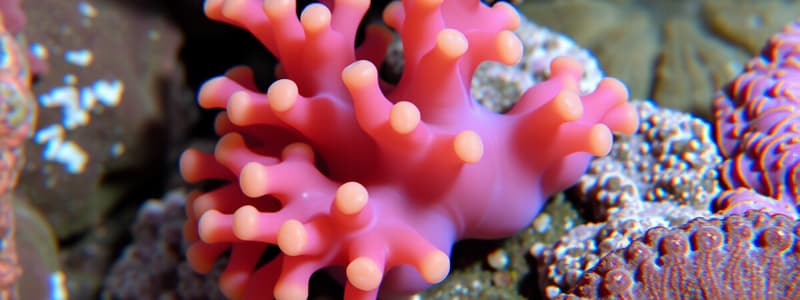Podcast
Questions and Answers
Which of the following are characteristics of Class Anthozoa?
Which of the following are characteristics of Class Anthozoa?
- They are found in all marine environments (correct)
- Medusa are present
- They possess a respiratory system
- They have a large and partitioned GVC (correct)
Name the three subclasses of Class Anthozoa.
Name the three subclasses of Class Anthozoa.
Zoantharia, Ceriantipatharia, Alcyonaria
What are zoantharia known for?
What are zoantharia known for?
Sea anemones and hard corals
What is the order of sea anemones?
What is the order of sea anemones?
The mouth of a sea anemone may contain a ciliated groove called a ______.
The mouth of a sea anemone may contain a ciliated groove called a ______.
What is the function of the GVC in sea anemones?
What is the function of the GVC in sea anemones?
What type of diet do sea anemones have?
What type of diet do sea anemones have?
How do sea anemones move?
How do sea anemones move?
What is an example of a mutualistic relationship involving sea anemones?
What is an example of a mutualistic relationship involving sea anemones?
What are the two modes of reproduction in sea anemones?
What are the two modes of reproduction in sea anemones?
What is the order of true or stony coral species?
What is the order of true or stony coral species?
Describe the skeletal structure of Alcyonaria.
Describe the skeletal structure of Alcyonaria.
Match the Alcyonaria examples with their common names:
Match the Alcyonaria examples with their common names:
Flashcards are hidden until you start studying
Study Notes
Class Anthozoa Characteristics
- Comprises sea anemones and corals, known as anthozoans or "flower animals."
- Exhibits flower-like polyps; medusa form is absent.
- Found in all marine environments, varying in size.
- Often supported by a skeleton; GVC is large, partitioned by septa or mesenteries.
- Muscle arrangement includes circular muscles and longitudinal/transverse muscles in septa.
- Mesoglea contains ameboid cells; exhibits biradial symmetry.
- Lacks excretory and respiratory systems, relying on diffusion for gas exchange.
Three Subclasses of Anthozoa
- Includes zoantharia, ceriantipatharia, and alcyonaria.
Zoantharia
- Consists of sea anemones and hard corals; follows hexamerous or polymerous plan (multiples of six).
- Features simple tubular tentacles arranged in circles on the oral disc; septa are paired.
Sea Anemone
- Classified under order actinaria; larger and heavier polyps than hydrozoans.
- Size ranges from less than 5mm to 100mm in diameter, and 5mm to 200mm long.
- Typically found in warmer coastal marine waters; attachment via pedal disc.
- Characteristic cylindrical form with tentacles around the mouth of the oral disc.
Sea Anemone Mouth
- Mouth connects to the pharynx; can have a ciliated groove called siphonoglyph that aids in water movement.
- Pharynx leads to the GVC.
Sea Anemone GVC
- Divided into six pairs of primary septa aiding water circulation.
- Smaller incomplete septa increase surface area and contain nematocysts for defense and prey capture.
Sea Anemone Food
- Carnivorous, feeding on fish and similar-sized organisms, whether living or dead.
Sea Anemone Movement
- Possesses a well-developed muscular system allowing for two main types of movement: slow gliding on the pedal disc and rhythmic swimming.
- Capable of retracting tentacles and oral disc when threatened.
Mutualistic Relationship
- Some species engage in symbiotic relationships, benefiting both organisms involved.
- Example: algae produce food for anemones through photosynthesis; clownfish coexist with anemones.
Sea Anemone Reproduction
- Asexual reproduction occurs through pedal laceration, where segments of the pedal disc regenerate new anemones.
- Sexual reproduction involves monoeicious or dieicious species, with fertilization occurring externally or in the GVC, leading to the formation of a ciliated larva.
Zoantharian Coral
- Classified under order scleractinia; also known as true or stony coral.
- Resembles miniature sea anemones within self-secreted calcareous cups.
- GVC subdivided by septa and lacks siphonoglyph, allowing retreat into the skeletal cup for protection.
Ceriantipatharia
- Characterized by unpaired septa; resides in warmer oceanic areas.
- Tube anemones are solitary and found buried in soft sediments.
- Thorny or black corals are colonial, attached to substrates with a skeletal structure composed of a horny material.
Alcyonaria (Octocorallia)
- Possesses strict octomerous symmetry with eight tentacles and unpaired complete septa.
- All members are colonial; GVCs communicate through gastrodermical tubes named solenia.
Alcyonaria Skeleton
- Comprised of limy spicules fused with a horny protein, creating an endoskeleton.
Alcyonaria Colors
- Contribute to the vibrant "submarine gardens" of coral reefs and exhibit colors like yellow, red, orange, and purple.
Alcyonaria Examples
- Notable species include sea fan (Subergorgia mollis), red whip coral (Ellisella), and organ pipe coral (Tubipora).
Studying That Suits You
Use AI to generate personalized quizzes and flashcards to suit your learning preferences.




